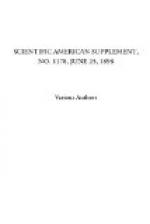In the mechanical process of reclaiming rubber, the rubber is separated from the fiber, after the whole has been finely ground, by means of an air blast, the method being not unlike that practiced by furriers for separating hair and fur from bits of pelt after skins have been finely divided. As the powdered waste comes from the blower, the rubber falls in a heap near the machine, while the particles of fiber, being lighter, are carried far enough away to make the separation complete. Devulcanization in this case is effected by exposure to live steam at a high temperature. No oil is used in the process, the sheeting of the product being facilitated by means of hot friction rollers.
The cost of reclaiming rubber by the acid process is less than by mechanical means, for which reason the former is now much more generally used. But some manufacturers are willing to pay more per pound for mechanically-reclaimed rubber, either (1) because it can be “compounded” more heavily than the acid product, or (2) because of certain inherent disadvantages of the latter. It is the testimony of these manufacturers that the action of sulphuric acid upon whiting (one of the most common adulterants used in rubber shoes) is to turn it into sulphate of lime—an ingredient which is far from advantageous in a rubber compound. Again, any acid which may remain in the reclaimed rubber is liable to rot thin textile fabrics with which it may be combined in manufacture. Finally, rubber recovered by the chemical process, it is claimed, is harder than that obtained by any other; so that it is usual to add, during vulcanization, in order to soften the product, the residuum obtained from petroleum manufactures, or palm or other oils. Unvulcanized rubber clippings also have been used for this purpose. One of the most successful of our rubber factory superintendents, who formerly made the reclaimed rubber used by his factory, has stated that his practice was to subject the material to an alkaline bath after the acid treatment, not only for the better cleaning of the rubber, but to neutralize any acid which might remain. Considering all the points involved, it was his opinion that, when scrap rubber is cheap, the mechanical process is the more economical, while, if it is high priced, the acid process has the advantage. Since this expression of opinion, however, prices of rubber scrap have ranged constantly at higher figures than before, and there is no indication that we shall have again what was known formerly as “cheap” scrap. It is not surprising, therefore, that the volume of mechanical “shoddy” should be placed by the best estimates at not above one-sixth of the total production of reclaimed rubber in the United States. And the acid product, with all its admitted shortcomings, is still superior to any of the so-called rubber substitutes.




